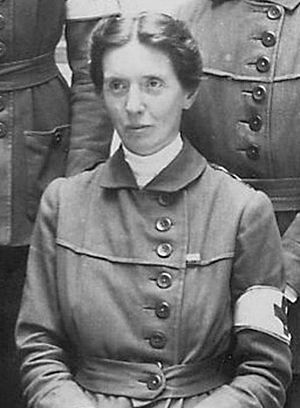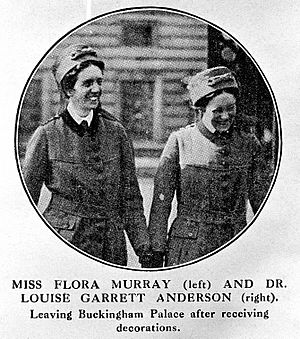Flora Murray facts for kids
Quick facts for kids
Flora Murray
|
|
|---|---|

Flora Murray in 1914
|
|
| Born | 8 May 1869 Murraythwaite, Dalton, Dumfriesshire, Scotland
|
| Died | 28 July 1923 (aged 54) Belsize Park, London, England
|
| Nationality | Scottish |
| Education | London School of Medicine for Women Durham University |
| Occupation | physician |
| Known for | suffragette |
| Relatives | Louisa Garrett Anderson (partner) |
Flora Murray, CBE (8 May 1869 – 28 July 1923) was a Scottish medical pioneer. She was also a member of the Women's Social and Political Union suffragettes, who fought for women's right to vote. From 1914 until her death, she lived and worked with her fellow doctor, Louisa Garrett Anderson.
Contents
Early Life and Education
Flora Murray was born on May 8, 1869, in Murraythwaite, Dumfriesshire, Scotland. Her father, John Murray, was a landowner and a captain in the Royal Navy. Flora was one of six children.
She first became interested in medicine in 1890. She attended a six-month nursing course at the London Hospital. After this, she decided to become a doctor. In 1897, she began studying at the London School of Medicine for Women.
Before becoming a doctor, Flora went to school in Germany and London. She then worked for 18 months at an asylum in Dumfriesshire. This experience helped her write her medical thesis in 1905. She finished her medical studies at Durham University. She earned her MB BSc in 1903 and her MD in 1905. In 1906, she also received a Diploma in Public Health from the University of Cambridge.
While in Scotland, Flora lived in Edinburgh with Dr Elsie Inglis. Elsie Inglis later started the Scottish Women's Hospitals movement.
Career
Becoming a Physician
In 1905, Flora Murray worked as a medical officer at the Belgrave Hospital for Children in London. She then became an anaesthetist (a doctor who gives medicine to make patients sleep during surgery) at the Chelsea Hospital for Women. In 1905, a medical journal called The Lancet published an article she wrote. It was about using anaesthetic for children.
Fighting for Women's Rights
Flora Murray was a strong supporter of women's right to vote. She first joined Millicent Fawcett's group, the National Union of Women's Suffrage Societies. Later, she supported the Women's Social and Political Union (WSPU). This group was known for its more active protests.
Flora was a leader in the movement. She spoke at public meetings and took part in protests. She used her medical skills to help other suffragettes who were injured during their activism. She also cared for leaders like Emmeline Pankhurst after they were released from prison. Flora and other doctors spoke out against the forced feeding of prisoners.
Women's Hospital for Children
In 1912, Flora Murray and Dr Louisa Garrett Anderson opened the Women's Hospital for Children. It was located at 688 Harrow Road in London. This hospital provided health care for working-class children in the area. It also gave women doctors a chance to gain experience in treating children. At that time, it was hard for women doctors to get such experience in London. The hospital's motto was Deeds not Words.
World War I Efforts
When World War I started, Flora Murray and Louisa Garrett Anderson created the Women's Hospital Corps (WHC). They recruited women to work in their medical teams. They believed the British War Office might not accept their help. So, they offered their services to the French Red Cross instead.
The French accepted their offer. They gave them a new hotel in Paris to use as a hospital. Flora Murray became the chief physician, and Louisa Garrett Anderson became the chief surgeon. Flora wrote in her diary that British War Office officials were surprised to see a hospital run so well by British women. Soon, their hospital was treated as a British hospital, not just a French one. The Women's Hospital Corps also ran another military hospital in Wimereux, France.
In January 1915, injured soldiers began to be sent to England for treatment. The British War Office asked Flora and Louisa to return to London. They were asked to run a large hospital called the Endell Street Military Hospital (ESMH). This hospital was part of the Royal Army Medical Corps. ESMH treated almost 50,000 soldiers between May 1915 and September 1919, when it closed.
After the war, Flora Murray returned to the Harrow Road hospital. It was renamed the Roll of Honour Hospital. She continued her work there as a private doctor. She wrote a book about her war experiences called Women as Army Surgeons: Being the History of the Women's Hospital Corps in Paris (1920). The book was dedicated to Louisa Garrett Anderson.
Eventually, the Roll of Honour Hospital closed due to lack of money. Flora and Louisa both retired. They moved to a small house in Penn, Buckinghamshire.
Death
Flora Murray had cancer and passed away on July 28, 1923, at the age of 54. She died shortly after surgery in a nursing home in Hampstead, London. Louisa Garrett Anderson was with her. Flora left everything she owned to Louisa in her will.
Flora Murray is buried at the Holy Trinity Church in Penn, Buckinghamshire. This is near the home she shared with Louisa. Later, Louisa Garrett Anderson was cremated. However, a shared tombstone remembers both women. It mentions Flora's work commanding the Endell Street Military Hospital.
Commemorations
In April 2022, it was announced that Flora Murray would appear on a new £100 banknote issued by the Bank of Scotland. This is to honor her important work in medicine and for women's rights. The banknote will feature a portrait of Flora Murray by artist Francis Dodd.
The head of the Royal Free London NHS Foundation Trust said that Flora's story reminds us of the great debt we owe to early activists. These people refused to accept limits placed on women in society. They showed that women could be doctors, physicians, and surgeons.
See also
 In Spanish: Flora Murray para niños
In Spanish: Flora Murray para niños



